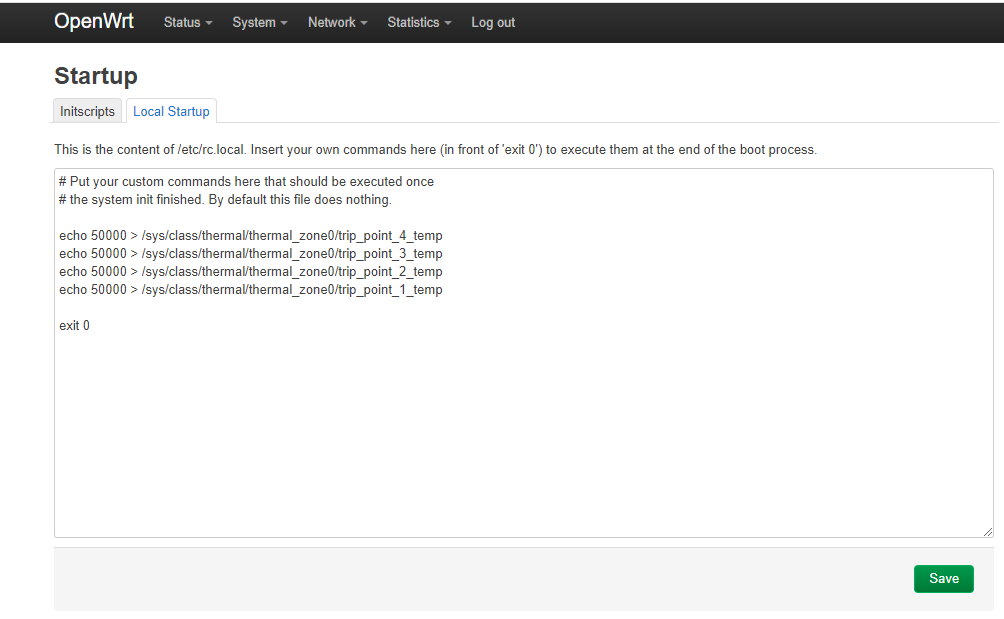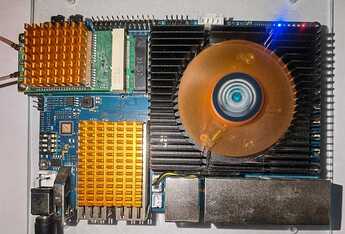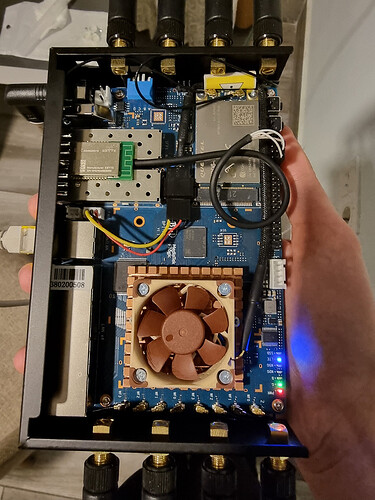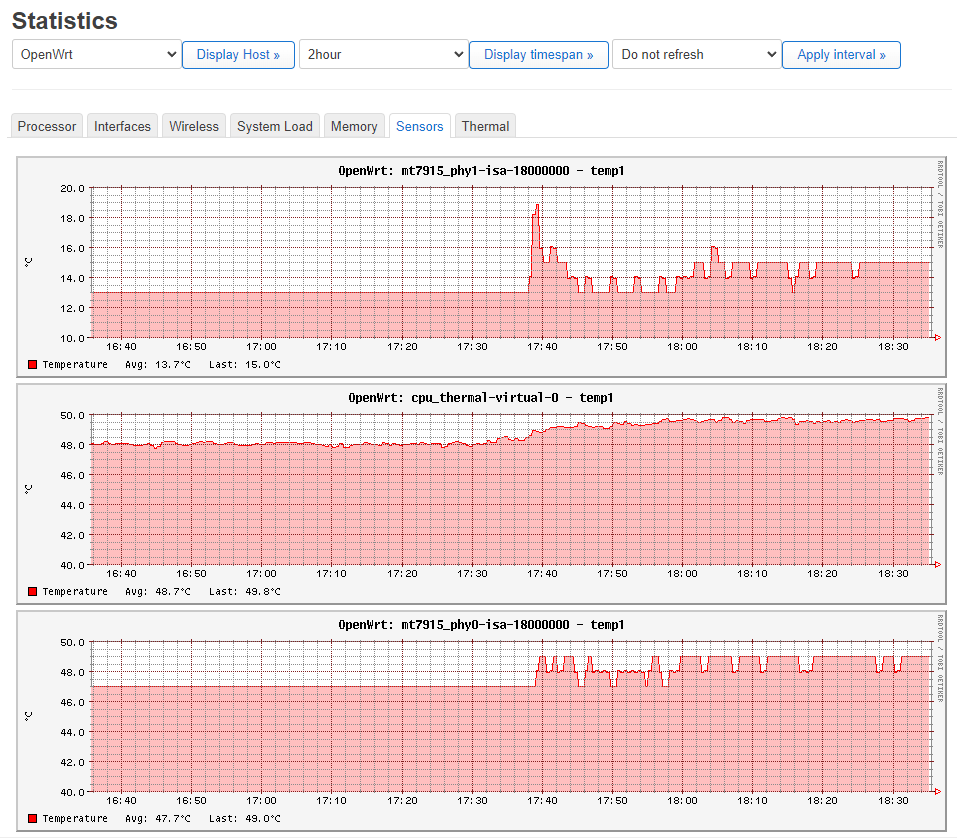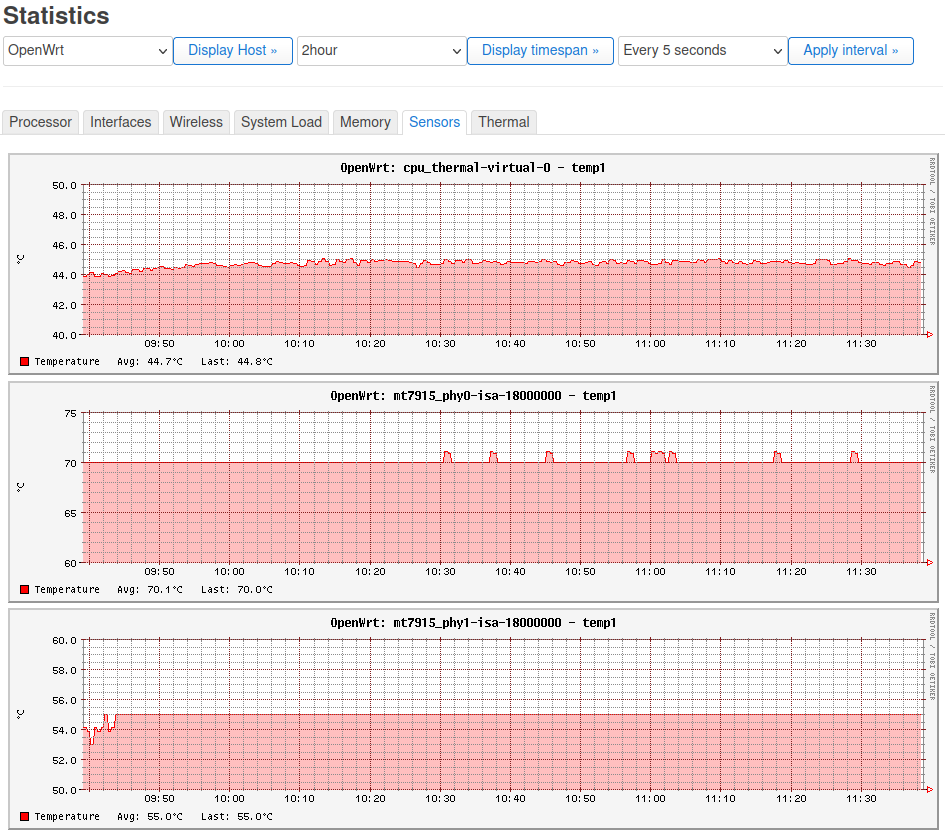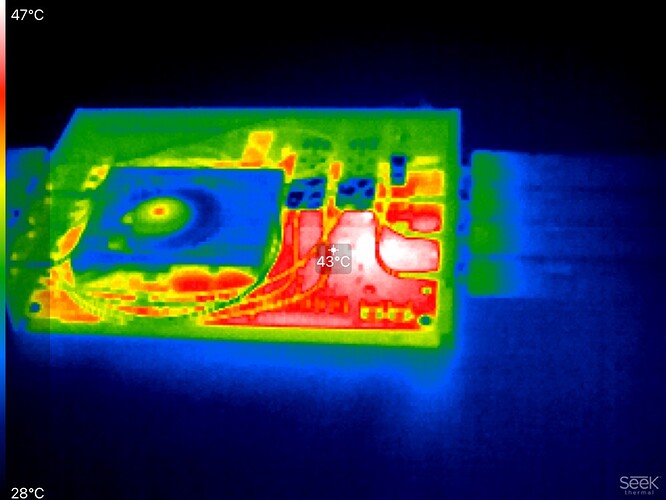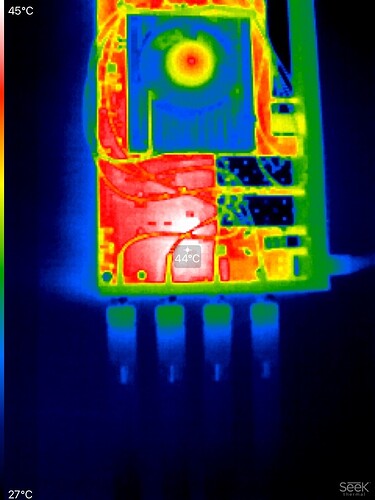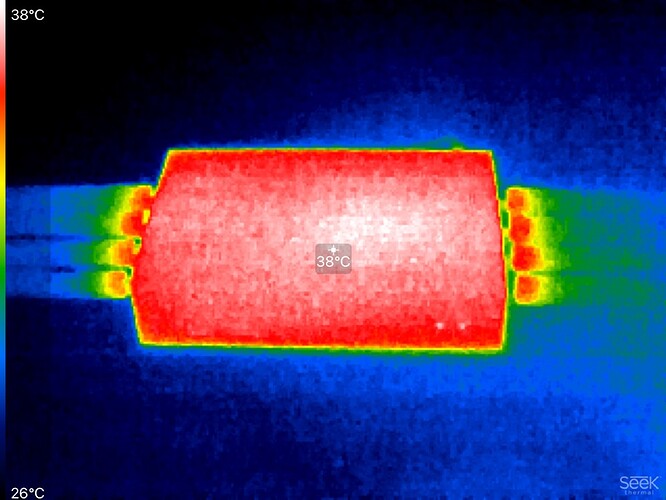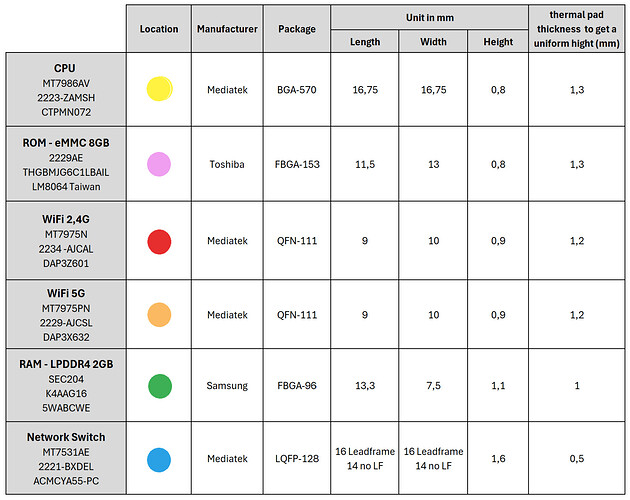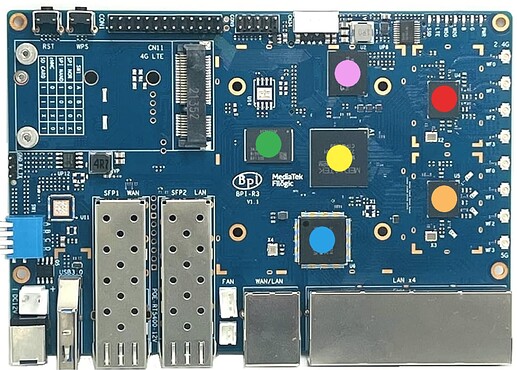How can you lower the temperature from 60º to 45º for example? I mean, what’s the file to change in OpenWRT for a pwm fan?
echo 50000 > /sys/class/thermal/thermal_zone0/trip_point_4_temp
echo 50000 > /sys/class/thermal/thermal_zone0/trip_point_3_temp
echo 50000 > /sys/class/thermal/thermal_zone0/trip_point_2_temp
echo 50000 > /sys/class/thermal/thermal_zone0/trip_point_1_temp
This will activate the fan at 50°c, for 45°c change the value to 45000
as mentioned in the screenshot, the file is : /etc/rc.local
I also tested the “new” echos for changing trip_point values.
My setup is a 55mm fan (PLD06010B12HH 12V 0.40A). The fan is capable of handling 5V and 12V. With 5V it runs slower. But I resoldered the 0Ω resistor on the bottom from R317 to R318. So it runs with 12V.
As the picture shows, i use the “normal” 3 pin port with PWM for running the fan.
My R3 runs the last stable openWRT firmware:
My results:
Yes, it is possible to set different values which effected the fan speed. I “read” how much work this was! ![]()
![]()
![]() I really like reading and working on the fan topic.
I really like reading and working on the fan topic.
But for me nothing changed. The fan runs the whole time and I can NOT turn the fan off ![]() . It is quiet and on the border to be hearable. With one or two meter distance, I would accept this at night (trip_point_1 & trip_point_4)!
. It is quiet and on the border to be hearable. With one or two meter distance, I would accept this at night (trip_point_1 & trip_point_4)!
During the useage of trip_point_2 & trip_point_3 the fan is too loud. And for the temperature I did not need it. For case usage, I would prefer to do much more holes in the case. Only the last choice would be turn on trip_point_3.
What I need would be manipulating the fan speed of the trip_points or that the fan turns off and on (lowest level <trip_point_1 & trip_point_4>).
If the future brings no advanced possibilities, I will may go back to 5V (fan runs lower) or try to use a resistor instead of 0 Ω resistor (R317 to R318) to lower the speed.
why did you use echo 05000 instead of 50000 ?? it means the fan will start at 5°C ![]()
Hello Rooot,
“my results” only show the summary of my attempts. The question was how to find out what every trip_point causes. I don’t want spend more time than i have to on this topic. So I had to found a temperature that activated only one trip_point per try.
The temperature of my CPU is 23°C.
Example for trip_point_4:
I’m hoping you understand it now. The other trip points are at 99,999°C and will not be activated. I could also take 10000 (10°C) or 20000 (20°C) → the purpose was to activete trip_point_4.
For presenting the results I have done the followed:
first:
second:
Why are you using the same temperature for trip_point_1-4:
My tests showed that the fan runs faster during the active trip_point_2 and lower at trip_point_3 (lowest was 1&4). I also find out, in case if you use the same temperature trip_point_2 will be activated!!!
Why not doing this?:
If the temperature is getting faster the fan will run faster!
Hi.
Do you have thermal pads over each chip under the official fan?
Thanks in advance.
I recently bought this self-adhesive thermal pad in combination with Skived Heat Sink which I still got to cut to dimensions. Worth to note that I 3D printed a case where all three parts, especially when it comes to ensuring the heat sink doesn’t fall off causing damage to the board, must be adjusted accordingly.
The offical fan should be delieverd with thermal pads. I do not have one, but looked on aliexpress:
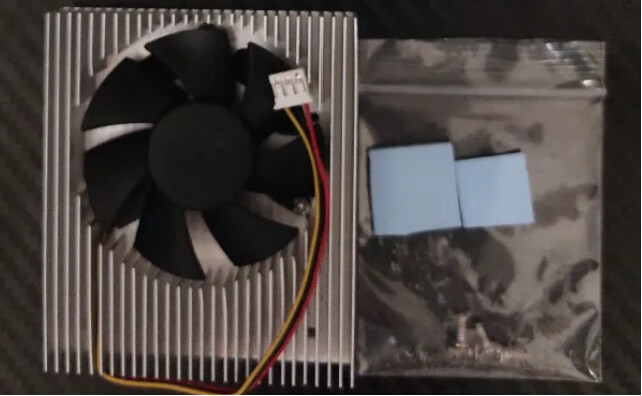
Please use thermal pads ![]()
not on the wifi chips, there are only 2 pads in the kit…anyway my temp is always below 50°c and my fan never start…or it starts but I never hear it even though it’s 1 meter away from my head
as you can see below, even with no thermal pad, and no contact between the wifi chips and the radiator, the temp never reach 50°c, My office is actually at 20°c
Ok.
I have put thermal pads over each chip under the official fan.
Cpu is running with a stable 44/45 º C.
Mt7915_phy0 shows a wrong temperature, but I can live with it ![]()
Thanks for those commands! The first only workable/easy solution I found here and elsewhere… those were my temps before running them:
root@OpenWrt:~# sensors
mt7915_phy0-isa-18000000
Adapter: ISA adapter
temp1: +53.0°C (high = +120.0°C, crit = +110.0°C)
cpu_thermal-virtual-0
Adapter: Virtual device
temp1: +54.4°C (crit = +125.0°C)
mt7915_phy1-isa-18000000
Adapter: ISA adapter
temp1: +86.0°C (high = +120.0°C, crit = +110.0°C)
And after letting the system go for a little while with no load nor connections (just starting to provision my BPI-R3 now):
root@OpenWrt:~# sensors
mt7915_phy0-isa-18000000
Adapter: ISA adapter
temp1: +45.0°C (high = +120.0°C, crit = +110.0°C)
cpu_thermal-virtual-0
Adapter: Virtual device
temp1: +44.6°C (crit = +125.0°C)
mt7915_phy1-isa-18000000
Adapter: ISA adapter
temp1: +78.0°C (high = +120.0°C, crit = +110.0°C)
I think it’s a shame that more conservative defaults are not applied since the case was fairly warm to the touch and could have damaged my system eventually… in other words: out of the box configs should not self-destruct the router ![]()
i’m the only one with a mt7915_phy1-isa-18000000 reporting 15°c ??
is +78.0°C a correct value ??
Sorry, i made a mistake when upstreaming the r3 thermal part dts due to my 3rd party pwm was not working with r3.
But you should be aware that mainline software support is done by only a few people,mainly daniel (also openwrt),wifi/hw offloading from lorenzo and some basic parts from me. These are development boards ![]()
Argh, sorry for my harsh word actually, “shame” is a bit too strong in this context, I should have used “pity”. If you show me how to modify the dts, I’d be happy to PR the changes to OpenWRT as penitence ![]()
Thanks Frank and others to maintain/fix those systems, I totally appreciate the efforts… I bought that board, so at least, I hope that helped somehow ![]()
Hello,
because of looking for a new PWM fan, I also thought about a new heatsink … . I know there is a fan for R3 but I may want to work with thermal paste. At the end it could be that I create a fansink which covers the whole area including SFP and 4G cellular modem. But this is just a dream…
Anyway, I tried to measure more exactly the chips height beneath the heatsink. I still have no digital caliper. But I got the information from internet and from a “piece of paper measurement”.
I know it sounds crazy, but after one day of thinking (How could I find something in my room that could measure in 0.1 mm steps), I realized and find out, that a piece of paper (HP Premium 90g/m^2) has 0.12 mm thickness . And because of the plain surface of the chips it is possible to use a ruler to get the differences between package heights. YES, crazy!
The measurement results matches really good with the information from internet. These is the summary:
The minimal thermal pad thickness is 0,5 mm (MT7531AE blue). After covering the chip packages surface with thermal pads, the heights should be 2,1 mm at all chips.
If something is wrong (heights, package, dimension), please write back to me!
Finding the dimensions of the different chip packages was not easy. It would be good if Banana pi could upload this data to the wiki.
Hallo again,
I learned some things about my fan(s) and frank’s post at R4 topic pushed me a bit:
First of all, I learnd that not only the PWM signal on the board is importand. I learnd that a PWM fan has microships inside which can effect the result.
I have two fans. This are my results overview with 5V and 12V:
The only fan which could be switched off was the PLD05010S12H @ 5V.
Next try would be a PLD06010S12L 55mm 0,2A. I have already ordered the fan. Should be here within a month …
Since everyone is messing around with them trip_point_x_temp variables, here’s a reference to the original defaults in case anyone prefers to go back.
Default trip_point_x_temp
| Set Point | Temp *C | Dec | Setting Notes |
|---|---|---|---|
| Set Point 0 | Critical | ? | Speed Level: 5 (Top Gun) |
| Set Point 1 | 120 *C | 120000 | Speed Level: 4 (Very Fast) |
| Set Point 2 | 115 *C | 115000 | Speed Level: 3 (Fast) |
| Set Point 3 | 85 *C | 85000 | Speed Level: 2 (Medium) |
| Set Point 4 | 60 *C | 60000 | Speed Level: 1 (Normal) |
echo 120000 > /sys/class/thermal/thermal_zone0/trip_point_1_temp #Set to 120*C
echo 115000 > /sys/class/thermal/thermal_zone0/trip_point_2_temp
echo 85000 > /sys/class/thermal/thermal_zone0/trip_point_3_temp
echo 60000 > /sys/class/thermal/thermal_zone0/trip_point_4_temp
Note: You can manually go to each file if you desired
cd /sys/class/thermal/thermal_zone0/
vi trip_point_1_temp
Additional PWM Fan Control
echo 0 > /sys/class/pwm/pwmchip0/export
echo 10000 > /sys/class/pwm/pwmchip0/pwm0/period
echo 5000 > /sys/class/pwm/pwmchip0/pwm0/duty_cycle
echo normal > /sys/class/pwm/pwmchip0/pwm0/polarity
echo 1 > /sys/class/pwm/pwmchip0/pwm0/enable
Reference: Getting Started with BPI-R3 - Banana Pi Wiki
As I understood, the recommendation for peak-cpu temp of the MediaTek MT7986 is <= 85°C. So I don’t understand the limits of 115 and 120°C. Shouldn’t the device already switch itself off if the CPU temperature rises above 90°C?
